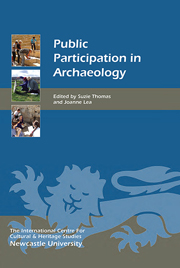Book contents
- Frontmatter
- Dedication
- Contents
- List of Illustrations
- Acknowledgments
- List of Abbreviations
- Preface
- Introduction
- Public Participation in Archaeology: International Models
- Public Participation in Archaeology Through Education
- Public Participation in Archaeology Through Tourism
- Public Participation in Archaeology Through Site Management and conservation
- List of Contributors
- Index
Introduction
Published online by Cambridge University Press: 05 August 2014
- Frontmatter
- Dedication
- Contents
- List of Illustrations
- Acknowledgments
- List of Abbreviations
- Preface
- Introduction
- Public Participation in Archaeology: International Models
- Public Participation in Archaeology Through Education
- Public Participation in Archaeology Through Tourism
- Public Participation in Archaeology Through Site Management and conservation
- List of Contributors
- Index
Summary
Public participation in archaeology has been an ongoing facet of humanity's interaction with its past, rather than a recent discovery. It has included a range of activity, from millennia of grave robbing, translating in the present time to criminal looting and trafficking of antiquities (Brodie et al 2000), through to the foundation of learned antiquarian societies that organised excavation outings for members and spectators at the mounds, barrows and tells of their choosing (Renfrew and Bahn 2004, 31). It was the 20th-century development of archaeology as an academic pursuit and profession, as more than a hobby, which imposed a divide between public participation and the archaeological past (Bray 2003, 41; Daniel 1975, 152; Smith 2004, 41). Under the establishment of heritage legislation, archaeological research and the accompanying finds and artefacts became subject to regulation relating to ownership, but also to stewardship on behalf of the public (English Heritage 2006, 1; Jameson 1994, 16; Murtagh 1997, 147; Zaslowsky and Watkins 1994, 106; and see Carman 2005 for a wider debate of ownership and cultural property).
By the latter part of the 20th century, it had been acknowledged that there was an inherent contradiction in acting on behalf of the public by keeping the public from direct participation with its archaeological heritage. Rather, heritage management was seen to need to include education, outreach and participation components, guided by the ethics of inclusion (Corbishley and Stone 1994, 389; Creamer 1990, 137; Flood 1989, 2; Jameson 1993, 2; McManamon 1991, 122; Rees 1999, 14).
- Type
- Chapter
- Information
- Public Participation in Archaeology , pp. 1 - 8Publisher: Boydell & BrewerPrint publication year: 2014

